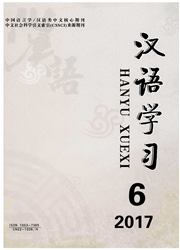

 中文摘要:
中文摘要:
本文基于本族语者双项并列宾语的排序原则,对留学生双项并列宾语的排序情况进行考察。本族语者使用的三大类十条原则在留学生中介语语料中均有出现,即语义由重到轻的显著性原则、熟悉程度原则、文化原则,语义由轻到重的发展程度原则、逻辑关系原则、重要性原则,无明显语义轻重的空间顺序原则、时间顺序原则、对应原则、形式原则等。留学生中介语语料中还发现了由小到大和个人熟悉程度两条新的排序原则。对比发现,除了显著性原则在两种语料中都强势使用外,本族语者和留学生在其他原则的使用倾向上存在明显差异,本族语者更倾向使用形式原则、发展程度原则,而留学生倾向于运用显著性原则和熟悉程度原则。
 英文摘要:
英文摘要:
This paper based on the native principle of binomial coordinate objects ordering, and investigated the situation that foreign students order the objects. We finds that what those three types, in all 10 principles the native use are all in the interlanguage corpus. Semantic focus from strong to weak: Significance principle, familiarity principle, and culture principle; Semantic focus from weak to strong: development principle, logical relation principle, and importance principle; No semantic focus: spatial sequence principle, time sequence principle, correspondence principle, and formation principle. In addition, it finds two new ordering principles that from small to big ordering and personal familiarity in the corpus that foreign students use. Through the comparison, it shows that, the native and foreign students have significant differences in usingtendency, except the strong usage for significance principle in both corpus. The native are more inclined to use formation principle and development principle, while the latter prefer to using significance principle and familiarity principle.
 同期刊论文项目
同期刊论文项目
 同项目期刊论文
同项目期刊论文
 期刊信息
期刊信息
